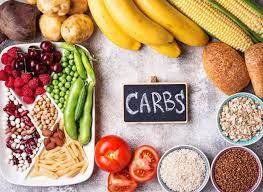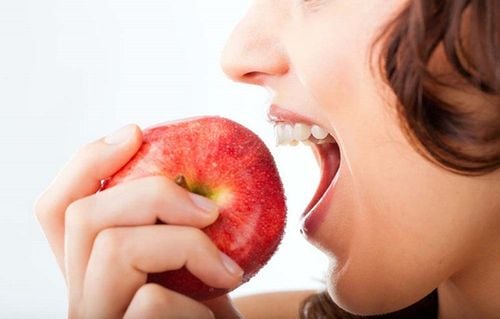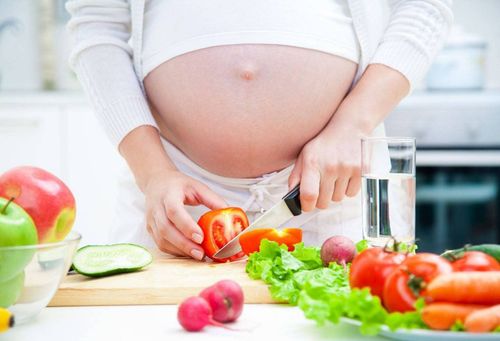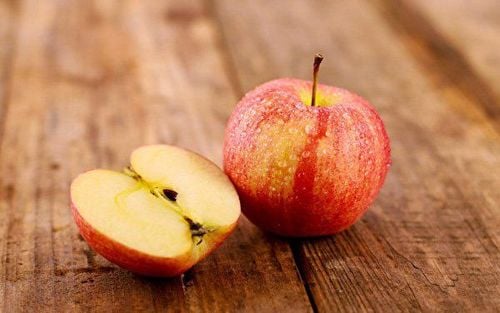This is an automatically translated article.
How much food you need depends on many factors, including your height, age, gender, general health, job, leisure time activities, physical activity, genetics, size your body, environmental factors, body composition, and any medications you may be taking. Here is the information for you to know how much to eat each day? Or how many calories to eat each day is enough.1. A few things to know about the food you need in a day
According to an Australian dietary guideline, each person is different at different ages, life stages and genders, the amount of food you need to eat each day is different but still must be enough. the amount of nutrients your body needs.Most people who want to lose weight should stick to the minimum number of servings. However, people within their healthy weight range, who are taller than average, or are more physically active, may find they need more servings from the five food groups.
Ideally, most servings should be chosen from the vegetable, fruit and whole grain food groups, but some supplement choices can be made with milk, yogurt, cheese and/or varieties substitutes, lean meat and poultry, fish, eggs and/or substitutes, and less often, fats or oils.
Usually, to get a serving that includes all the food groups you need:
Swap options for foods from the 4 main food groups Use bread or cereal for at least one meal on most days. Eat vegetables at least twice a day, especially if you want to lose weight Eat lean meats or meat substitutes for at least 1 meal a day Add fruit to at least two meals or serve as a snack or dessert Use a serving of low-fat milk, yogurt or cheese as an important part of at least two meals or snacks. Add fish and beans to meals. And the most important thing you need to keep in mind is:
If you consume more calories than you burn, you are likely to gain weight. To lose weight, reducing your calorie intake and increasing the number of calories you burn is essential. Eat a variety of natural foods for a healthy body.
2. Daily calorie requirements for both men and women.
Calories are a measure of the amount of energy contained in the food we eat. Understanding calories will help us figure out how much to eat. Different foods have different number of calories per gram or weight. Eating less or more is closely related to calorie consumption.Here are some daily calorie needs for both men and women. Activity level is a period of at least 60 minutes of moderate activity per day.
Male
| Tuổi tác | Mức độ ít vận động | Mức độ hoạt động thấp | Mức độ hoạt động |
| 2-3 tuổi | 1.100 | 1.350 | 1.500 |
| 4-5 tuổi | 1.250 | 1.450 | 1.650 |
| 6-7 tuổi | 1.400 | 1.600 | 1.800 |
| 8-9 tuổi | 1.500 | 1.750 | 2.000 |
| 10-11 tuổi | 1.700 | 2.000 | 2.300 |
| 12-13 tuổi | 1.900 | 2.250 | 2.600 |
| 14-16 tuổi | 2.300 | 2.700 | 3.100 |
| 17-18 tuổi | 2.450 | 2.900 | 3.300 |
| 19-30 tuổi | 2.500 | 2.700 | 3.000 |
| 31-50 tuổi | 2.350 | 2.600 | 2.900 |
| 51-70 tuổi | 2.150 | 2.350 | 2.650 |
| Hơn 71 tuổi | 2.000 | 2.200 | 2.500 |
| Tuổi tác | Mức độ ít vận động | Mức độ hoạt động thấp | Mức độ hoạt động |
| 2-3 tuổi | 1.100 | 1.250 | 1.400 |
| 4-5 tuổi | 1.200 | 1.350 | 1.500 |
| 6-7 tuổi | 1.300 | 1.500 | 1.700 |
| 8-9 tuổi | 1.400 | 1.600 | 1.850 |
| 10-11 tuổi | 1.500 | 1.800 | 2.050 |
| 12-13 tuổi | 1.700 | 2.000 | 2.250 |
| 14-16 tuổi | 1.750 | 2.100 | 2.350 |
| 17-18 tuổi | 1.750 | 2.100 | 2.400 |
| 19-30 tuổi | 1.900 | 2.100 | 2.350 |
| 31-50 tuổi | 1.800 | 2.000 | 2.250 |
| 51-70 tuổi | 1.650 | 1.850 | 2.100 |
| Hơn 71 tuổi | 1.550 | 1.750 | 2.000 |
3. How much food does your body need each day
According to Health Canada, each person should consume the following recommended servings each day.2-3 years old : Fruits and vegetables 4, Grains 3, Milk (and alternatives) 2, Meat (and alternatives) 1. 4-8 years old : Fruits and vegetables 5, Whole grains cup 4, Milk (and alternatives) 2, Meat (and alternatives) 1. 9-13 years old : Fruits and vegetables 6, Grains 6, Milk (and alternatives) 3-4, Meat (and alternatives) 1-2. 14-18 years old (male) : Fruits and vegetables 8, Grains 7, Milk (and alternatives) 3-4, Meat (and alternatives) 3. 14-18 years old (female) : Fruit and vegetables 7, Cereals 6, Milk (and alternatives) 3-4, Meat (and alternatives) 2. 19-50 years old (male) : Fruits and vegetables 8-10, Grains 8 , Milk (and alternatives) 2, Meat or alternatives 3. 19-50 years old (females): Fruits and vegetables 7-8, Cereals 6-7, Milk (and alternatives) 2 , Meat (and alternatives) 2. Age 51 and older (male): Fruits and vegetables 7, Grains 7, Milk (and alternatives) 3, Meat (and alternatives) 3. 51 years old (female) : Fruits and vegetables 7, Grains 6, Milk (and alternatives) 3, Meat (and alternatives) 3. Some sample meals Male 19 - 50
| Món ăn | Trọng lượng / khẩu phần | Nhóm thực phẩm và số lượng phục vụ |
| Bữa ăn sáng | ||
| Bánh mì nướng nguyên hạt với bơ thực vật không bão hòa đa |
2 lát bánh mì nướng 2 muỗng cà phê bơ thực vật |
2 hạt phục vụ 10g phết không bão hòa (1 phần ăn) |
| Đậu nướng | 1/2 chén đậu đóng hộp | 1 phần rau |
| Cà chua | 1 quả cà chua vừa | 1 phần rau |
| Ly sữa giảm | 1 cốc (250ml) | 1 suất sữa / sữa chua / phô mai |
| Nghỉ buổi sáng | ||
| Táo | 1 quả | 1 phần trái cây |
| Cà phê sữa | 200ml (cà phê nhỏ) | 1/4 sữa / sữa chua / phô mai |
| Bữa trưa | ||
| Sandwich ngũ cốc nguyên hạt với thịt bò nướng, pho mát giảm béo và salad trộn với margarine không bão hòa đa |
2 lát bánh mì 65g thịt bò nướng 20g phô mai 2 thìa cà phê bơ thực vật 1 chén rau trộn salad |
2 ngũ cốc phục vụ 1 thịt và / hoặc các loại thay thế phục vụ 1/2 sữa / sữa chua / pho mát phục vụ 10g phết không bão hòa (1 phần ăn) 1 phần rau |
| Nghỉ buổi chiều | ||
| Các loại hạt không ướp muối | 30g | 1 suất thịt và / hoặc thức ăn thay thế |
| Cà phê sữa | 200ml (cà phê nhỏ) | 1/4 sữa / sữa chua / phô mai |
| Bữa ăn tối | ||
|
Cá chế biến với dầu ô liu Cơm luộc Khoai tây Cà rốt Bông cải xanh |
100g cá phi lê nấu chín 14g dầu không bão hòa 1 chén cơm sôi 1/2 củ khoai tây vừa 1/2 chén 1/2 chén |
1 phần thịt và / hoặc các món thay thế phục vụ 14g dầu không bão hòa (2 phần ăn) 2 phần ngũ cốc 1 phần ăn rau 1 phần ăn rau 1 phần ăn rau |
| Bữa ăn nhẹ buổi tối | ||
| Salad trái cây và sữa chua giảm béo |
1 cốc trái cây tươi thái hạt lựu 100g sữa chua |
1 phần trái cây 1/2 phần sữa / sữa chua |
| Thực phẩm bữa ăn | Trọng lượng / khẩu phần | Nhóm thực phẩm và số lượng phục vụ |
| Bữa ăn sáng | ||
| Ngũ cốc ăn sáng nguyên hạt, với sữa giảm béo |
60g ngũ cốc 1 cốc (250ml) sữa giảm bé |
2 ngũ cốc phục vụ 1 suất sữa / sữa chua / phô mai |
| Sữa chua giảm béo | 100g sữa chua | 1/2 suất sữa / sữa chua / phô mai |
| Nghỉ buổi sáng | ||
| Cà phê sữa | 200ml (cà phê nhỏ) | 1/4 sữa / sữa chua / phô mai |
| Bữa trưa | ||
| Sandwich với salad và gà |
2 lát bánh mì 40g thịt gà 1 muỗng cà phê bơ thực vật 1 chén salad rau |
2 ngũ cốc phục vụ ½ thịt và / hoặc các loại thay thế phục vụ 5g hỗn hợp không bão hòa (½ khẩu phần) 1 khẩu phần rau |
| Táo | 1 phương tiện | 1 phần trái cây |
| Nghỉ buổi chiều | ||
| Các loại hạt không ướp muối | 30g | 1 suất thịt và / hoặc thức ăn thay thế |
| Cà phê sữa | 200ml (cà phê nhỏ) | 1/4 sữa / sữa chua / phô mai |
| Bữa ăn tối | ||
| Mì ống với thịt bò băm và đậu tây đỏ, cà chua và xà lách xanh với dầu ô liu và sốt giấm |
1 chén mì ống nấu chín 65g thịt băm nấu chín 1/4 chén đậu tây 1½ quả cà chua vừa 1/2 củ hành tây 2 chén salad lá xanh 2 muỗng cà phê dầu không bão hòa |
2 khẩu phần ngũ cốc phục vụ 1 phần thịt và / hoặc khẩu phần thay thế 1½ phần ăn rau 1/2 phần ăn rau 2 phần ăn rau 14g dầu không bão hòa (2 phần ăn) |
| Bữa ăn nhẹ buổi tối | ||
| Mận và sữa chua giảm béo |
1 cốc mận hầm 100g sữa chua |
1 phần trái cây 1/2 phần sữa / sữa chua / pho mát |
4. Suitable food sizes
Below is a reference amount to help you determine the amount of food in the 5 main food groups that you consume daily.Fruit A standard serving is approximately 150g equivalent of
+ 1 medium apple, banana, orange or pear
+ 2 small apricots, kiwis or plums
+ 1 cup diced or canned fruit (no added sugar)
Occasionally add
+ 125ml (1/2 cup) fruit juice (no added sugar)
+ 30g dried fruit
Vegetables A standard serving is about 75g (100–350kJ) or :
+ 1/2 cup cooked greens or oranges (eg, broccoli, spinach, carrots or squash)
+1/2 cup dried or canned beans, peas or lentils cooked (preferably no salt)
+ 1 cup leafy greens or raw lettuce
+1/2 cup sweet corn
+1/2 medium potatoes or other starchy vegetables (sweet potatoes, potatoes) taro or cassava)
+1 medium tomato
Cereal +1 slice of bread (40g)
+ 1/2 medium roll or flatbread (40g)
+ 1/2 cup (75-120g) cooked rice, pasta, noodles, barley, buckwheat, semolina, peas, bulgur or quinoa
+ 1/2 cup (120g) cooked porridge
+ 2/3 cup (30g) flour wheat cereal
+ 3 (35g) crusty bread
+ 1 (60g) crumpet
+ 1 muffin or small English muffin (35g)
* Cereal (cereal), staple are whole grains and/or high-fiber cereals
Milk and alternatives A standard serving is (500–600kJ):
+ 1 cup (250ml) fresh long-lasting pasteurized, powdered milk reconstituted or skimmed milk
+ 1/2 cup (120ml) condensed milk
+ 2 slices (40g) or 4 x 3 x 2cm (40g) chunks of hard cheese, such as cheddar
+ 1/2 cup (120g) ricotta cheese
+ 3/4 cup (200g) yogurt
+ 1 cup (250ml) soy sauce, rice or other cereal with at least 100mg of added calcium per 100ml
* Choose most reduced fat
If you don't eat any of the foods in this group, try the following foods, which contain the equivalent amount of calcium as a serving of milk, yogurt, cheese, or alternatives (saves) Note: The kilojoule content of some of these foods (especially nuts) is higher, so see this if you are trying to lose weight).
+ 100g shelled almonds
+ 60g sardines, canned in water
+ 1/2 cup (100g) canned pink salmon with bones
+ 100g firm tofu (check label because calcium content varies)

Với hoa quả, bạn nên ăn khoảng 150g mỗi ngày
+ 65g cooked lean red meat such as beef, lamb, veal, pork, goat or kangaroo (about 90-100g) raw)
+ 80g lean cooked poultry like chicken (100g raw)
+ 100g cooked fish fillets (about 115g raw) or a can of small fish
+ 2 large eggs (120g)
+ 1 cup (150g) ) cooked or canned beans such as lentils, chickpeas or peas (preferably no salt added)
+ 170g tofu
+ 30g nuts, seeds, peanuts or almond butter or nuts or other nut meal (no salt added)
* Used only occasionally as a substitute for other foods in the group (note: this amount for nuts provides approximately the same energy as other foods in the group). this group but will provide less protein, iron or zinc).
Consume fruits and vegetables Experts say you should consume at least one dark green and one orange per day. Examples of dark green vegetables include spinach, kale, and broccoli.
Should steam, bake or boil vegetables. Limit or avoid foods that are thoroughly fried. Whole fruits and vegetables are a better choice than their juices, as they provide more nutrients and fiber. They also fill you up for longer, which can prevent overeating.
Consume grains Nutritionists recommend eating whole grains in half of your cereal servings. Choose from a variety of grains, including quinoa, oats, brown rice, and barley. Whole-grain pasta, oatmeal, and bread are better than those made with refined grains.
A good cereal should not be high in sugar, salt or fat. Alternatives to grains that contain many of the same nutrients are beans, legumes, quinoa, and starchy vegetables like sweet potatoes and peas.
Milk and milk substitutes Drink 2 cups a day for vitamin D and calcium . If you don't drink milk, drink a supplement. Limit milk intake with added sugar and other sweeteners. Low-fat milk may be recommended if you are limiting total fat or saturated fat for heart health reasons.
Meat and alternatives Make sure you are eating alternatives, such as tofu, lentils and beans regularly. Eat fish at least twice a week. Be careful with certain types of fish exposed to mercury like tuna. Choose lean meats, such as chicken.
Instead of frying, try roasting, baking, or boiling. If you're eating processed or prepackaged meat, choose low-salt and low-fat varieties. Limit your overall intake of processed meats because you can increase your risk of cancer if eaten regularly.
When eating carbohydrates, choose unrefined carbs, such as whole grains, that are high in fiber and release energy slowly, so you feel full for longer.
Limit saturated fat and avoid trans fat as much as possible. You should consume no more than 10 percent of your total calories from saturated fat. Vegetable oils, fish and nuts are the best sources.
Make sure to provide plenty of fiber. When eating fruits and vegetables, eat a variety of colors. If you're not a milk drinker, make sure you're consuming enough calcium.
If your main concern is knowing how much food you should eat, you still have to know about their caloric value. With high-calorie foods, the quantity will be less, while with lower-calorie foods, you can eat more.

Khi tiêu thụ các loại thực phẩm chứa carbs, hãy hạn chế carbs tinh chế
5. Some related studies
In some people, strict restriction of daily calorie intake may prolong life overall.Animal studies show that some species seem to live longer if they are partially starved, but these are considered "poor quality" studies, and it is unlikely that calorie restriction will have any effect. the same for humans.
However, scientists from Louisiana State University in Baton Rouge explained in the journal Nature, in 2012, that the two main factors that influence longevity are good genes and a healthy, balanced diet .
Researchers believe that many previous studies were wrong when they compared a high-calorie diet with a very low-calorie diet.
A study published in the American Journal of Clinical Nutrition in 2013, found that if you eat a serving of fruits and vegetables "5 days a week", you are likely to live longer
2016, The researchers concluded that the effect of diet on aging "is not simply the result of reduced calorie intake, but is also determined by diet composition."
References: eatforhealth.gov.au, medicalnewstoday.com













